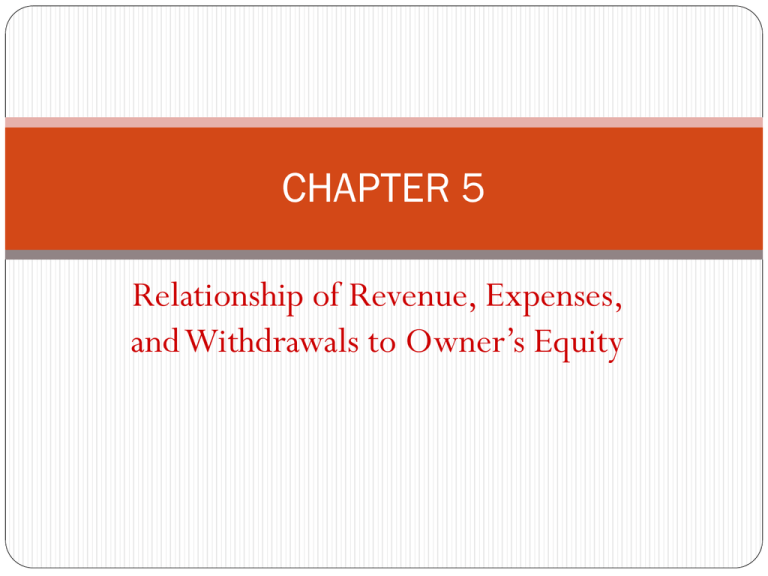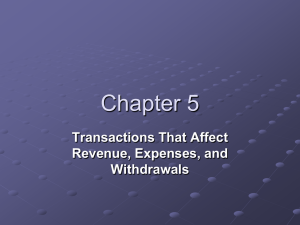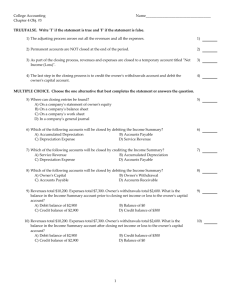
CHAPTER 5
Relationship of Revenue, Expenses,
and Withdrawals to Owner’s Equity
SECTION 5.1
Relationship of Revenue, Expenses, and
Withdrawals to Owner’s Equity
Temporary and Permanent Accounts
Revenues, expenses, and withdrawals could be
recorded as increases or decreases in the capital
account.
A better way to record these transactions is to set up
separate accounts for each type of revenue or
expense.
Glencoe Accounting Unit 2
Chapter 5 Copyright © by The
McGraw-Hill Companies, Inc. All
rights reserved.
SECTION 5.1
Using Temporary Accounts
Use temporary accounts to temporarily record information for
revenues, expenses and withdrawals.
Temporary accounts
start the accounting period with a
zero balance,
accumulate amounts for
one accounting period, and
transfer the balance to the owner’s capital account at the end of
the period.
Glencoe Accounting Unit 2
Chapter 5 Copyright © by The
McGraw-Hill Companies, Inc. All
rights reserved.
Using Permanent Accounts
In contrast to temporary accounts, permanent accounts
continue accumulating from one accounting period to the
next. The owner’s capital account and the asset and liability
accounts are permanent accounts.
Permanent accounts show
the balances on hand or amounts owed at any time, and
the day-to-day account changes.
SECTION 5.1
Rules for Revenue Accounts
These rules of debit and credit are used for revenue accounts:
A revenue account is increased on the credit side.
A revenue account is decreased on the debit side.
The normal balance for a revenue account is the increase or the credit
side. Revenue accounts normally have credit balances.
Glencoe Accounting Unit 2
Chapter 5 Copyright © by The
McGraw-Hill Companies, Inc. All
rights reserved.
SECTION 5.1
Relationship of Revenue, Expenses, and Withdrawals to Owner’s
Equity
Rules for Expense Accounts
These rules of debit and credit are used for expense
accounts:
An expense account is increased on the
debit side.
An expense account is decreased on the
credit side.
The normal balance for an expense account is the
increase or the debit side. Expense accounts
normally have debit balances.
Glencoe Accounting Unit 2
Chapter 5 Copyright © by The
McGraw-Hill Companies, Inc. All
rights reserved.
SECTION 5.1
Rules for Expense Accounts
Glencoe Accounting Unit 2
Chapter 5 Copyright © by The
McGraw-Hill Companies, Inc. All
rights reserved.
SECTION 5.1
Rules for Withdrawals Accounts
These rules of debit and credit are used for withdrawals
accounts:
A withdrawals account is increased on the
debit side.
A withdrawals account is decreased on the
credit side.
The normal balance for a withdrawals account is the
increase or the debit side. Withdrawals accounts
normally have debit balances.
Glencoe Accounting Unit 2
Chapter 5 Copyright © by The
McGraw-Hill Companies, Inc. All
rights reserved.
SECTION 5.1
Rules for Withdrawals Accounts
Glencoe Accounting Unit 2
Chapter 5 Copyright © by The
McGraw-Hill Companies, Inc. All
rights reserved.
Relationship of Revenue, Expenses, and Withdrawals to Owner’s Equity
Summary of the Rules of Debit and Credit for
Temporary Accounts
Glencoe Accounting Unit 2
Chapter 5 Copyright © by The
McGraw-Hill Companies, Inc. All
rights reserved.





